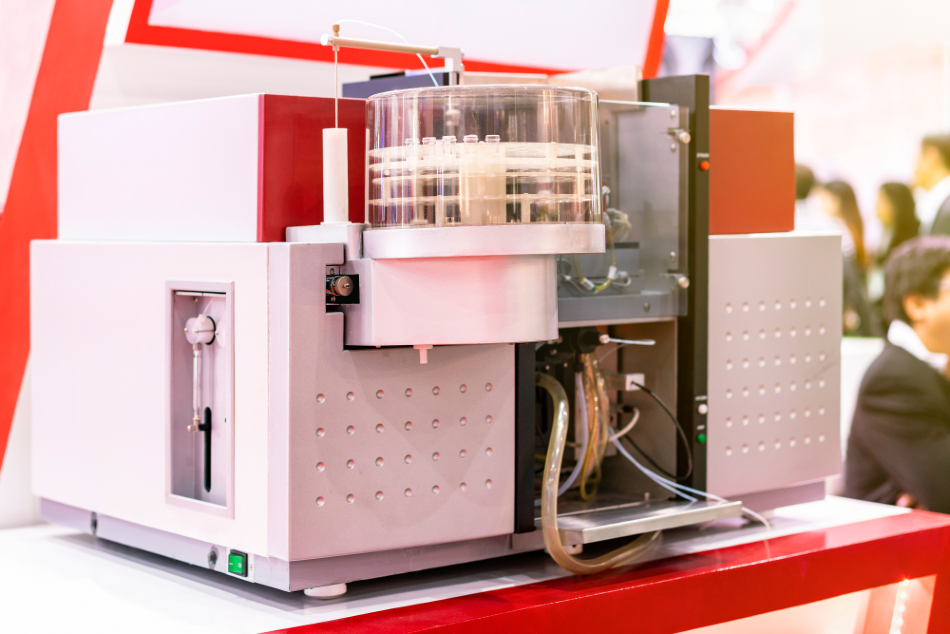
Image Credit: Surasak_Photo/Shutterstock.com
Atomic absorption spectrometry (AAS) is a technique that has undergone significant development since the first work with spectroscopy was described back in 1648. It is a method where free gaseous atoms absorb electromagnetic radiation at a specific wavelength to produce a measurable signal. The concentration of the gaseous atoms in the optical path proportionally amends the absorption signal, so that the concentration of an element can be reliably measured.
The first stage of the process requires an atomizer to convert the sample into gaseous atoms, either a flame AAS (FAAS) or an electrothermal AAS (ETAAS) is used, and these two different methods define the two types of atomic absorption spectrometry that are currently widely used.
The first commercial AAS spectrometers were produced in the 1950s after British physicist Sir Alan Walsh discovered various applications for the technology. Since then, many advancements have been made, and the tool has established itself as a vital piece of equipment in various industries, such as food and beverage, agriculture, chemical, life sciences, pharmaceutical, environmental (particularly water), and even in mining operations.
The market is currently valued at $470 million and it continues to grow as new developments are made. Experts predict that the global atomic absorption spectroscopy market will grow at a CAGR of roughly 6.5% from now until 2024, reaching a value of $680 million by the end of the five years.
AAS has developed into an inexpensive, high-throughput technique that can reliably analyze a variety of compounds in solution. For these reasons, it is growing in popularity. and receives attention from research teams who aim to expand the technology. Recently, there has been no single area that has dominated research in this field, rather, there have been many recent publications that have identified several streams of development that are occurring simultaneously.
Developments in LIBS
A number of recent studies have developed extensions of the laser-induced breakdown spectroscopy (LIBS) approach. Out of this research has come the establishment of two novel techniques, the hybrid RAMAN/LIBS technique which is used for remote sensing, and the phase selective (PS)-LIBS, which has been created to analyze nanoparticles.
Dielectric Barrier Discharge
A significant amount of research is also underway in developing the use of the dielectric barrier discharge (DBD), which was first established as a compact excitation/ionization source. New research has enabled DBD to be developed for vapor generation, sample digestion, and analyte trapping.
The advancements here have been pushed forward by industry need for portable and integrated systems for use in field applications. In the future, we can expect work to continue in this field, developing more efficient and accessible devices that are in high demand.
Non-Radiogenic, Heavier Isotopes
The third most notable line of research is the development of isotope ratio analysis for a wider range of non-radiogenic, heavier isotopes. As research continues, their number grows, with recent developments seeing tellurium (Te) included.
Recently Developed Applications
Research into expanding the capabilities of AAS has led to a number of new applications being recently established, including quantitative determination of lead in contaminated soil, compost and plant samples; solubility tests of salts in the presence of other ions; nutrient analysis in water samples from hydroponics beds kept under various conditions; quantitative determination of calcium, sodium, magnesium, and potassium in Himalayan rock salt; analysis of stream water for various elements; and analysis of various oils and organic tissues for toxic metals, such as lead.
Summary
Future developments of AAS will likely continue along the lines of the recent developments that have been dominating the space. The above-discussed streams of research have yet to fulfill their potential, and future innovations are expected to come from these focus points.
Sources and Further Reading
Disclaimer: The views expressed here are those of the author expressed in their private capacity and do not necessarily represent the views of AZoM.com Limited T/A AZoNetwork the owner and operator of this website. This disclaimer forms part of the Terms and conditions of use of this website.